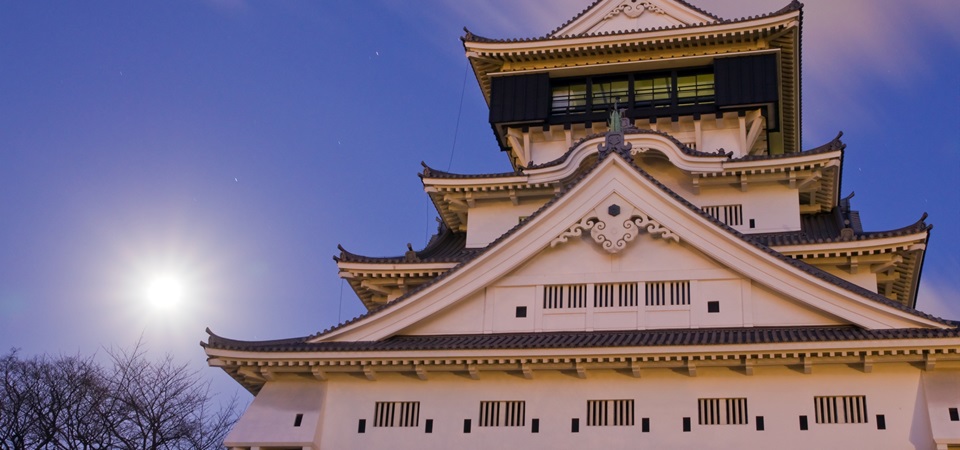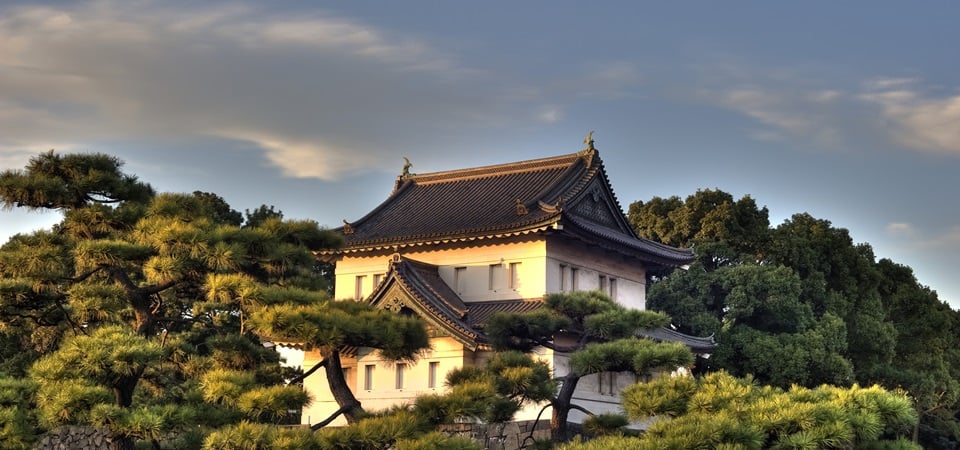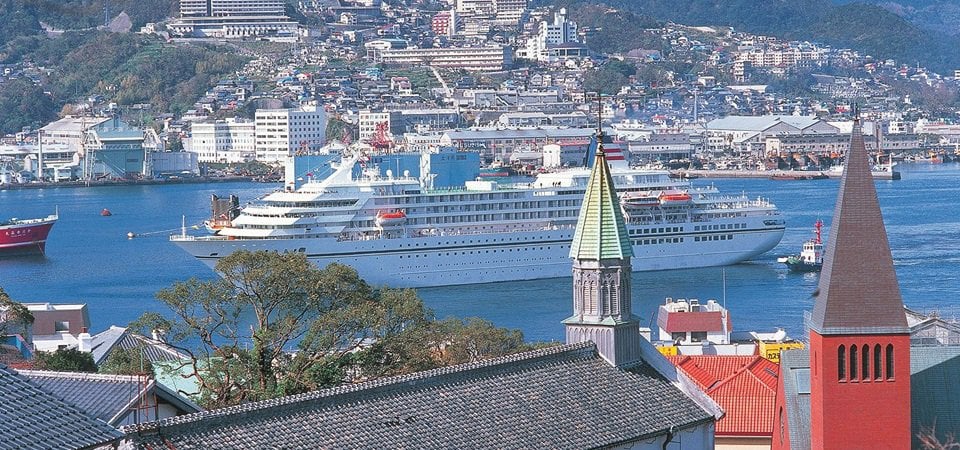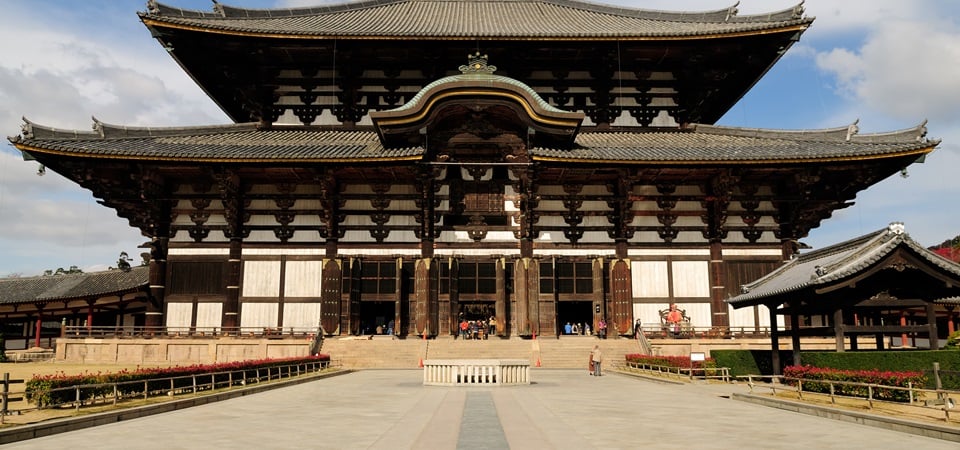Discover the treasure trove of wonders that lie at the southern tip of Japan. After an in-depth look at UNESCO-heritage Kyoto, head to Shikoku Island to explore arts villages, pilgrimage trails and pristine nature. Then it’s on to Kyushu Island where historic cities, ancient monuments and tranquil hot springs beckon.
Itinerary
📍 Kansai International Airport (KIX) to Central Kyoto: 2 h
Upon arrival to Kansai International Airport, our guide will be waiting to assist with transportation to the hotel in Kyoto (via shared shuttle van).
The rest of the day is at leisure.
Overnight in Kyoto
Inclusions:
📍 Time: Start: 9:30, 12:00 or 14:30 Duration: approx. 2 h
Today, be immersed in Japanese culture with this insightful half day trip in Kyoto. Start with a visit to a machiya, a traditional wooden townhouse found throughout Kyoto. Take a tour of the beautifully restored house, learning about its architecture and history.
Then slip into a kimono, the iconic traditional Japanese garment. These full-length robes are worn by all Japanese when attending important events or formal occasions. Once appropriately dressed, meet with a local tea master for a traditional ceremony. Watch and learn as the master brews and services tea using slow, deliberate movements steeped in spirituality and ritual. Enjoy a cup of the bitter tea along with traditional sweet treats.
After the tea is finished, continue the cultural exploration of Kyoto. Enjoy an introductory course in origami, the Japanese art of paper folding. Under the guidance of a local artist, learn the secrets behind creating beautiful decorations and images with simple pieces of paper.
Wrap up the half day trip in Kyoto with new insights and a better understanding of Japanese culture. Return to the hotel or continue to explore Kyoto’s charming streets.
The rest of the day is at leisure.
Overnight in Kyoto
Inclusions:
☕ Breakfast
📍 Time: Start (guided tour): 09:00 Duration: 8 h *including pick-up/drop-off and transit times
Today’s tour starts with a visit to one of Kyoto’s most iconic sites: the Fushimi Inari Shinto Shrine. A lavishly decorated building houses the goddess of rice, and thousands of orange torii gates stretch up the mountainside in long tunnels. Unlike any other shrine in Japan, this is an ideal spot to understand how Shintoism is tied to respect for nature.
Board a train to Sanjusangendo, a stunning Buddhist temple often overlooked by tourists. A mesmerizing display of 1001 life-sized golden Buddhist statues awaits inside the world’s longest wooden building, sure to be one of the most memorable sights of the entire trip.
Take a taxi to the entrance of Nishiki Market, a long covered street of shops and stalls often called “Kyoto’s kitchen.” From traditional to sellers of tofu, fish, and pickles to shops showcasing knives and handicrafts, there is a tantalizing amount of things to see and taste here.
Don’t get too full snacking in the market, as lunch is next at a nearby restaurant. The guide will suggest locations based on the guests’ preferences (guests should notify guide of dietary restrictions at the start of the tour).
After lunch, travel to Nijo Castle, an ornamental palace built for the shogun in the early 1600s. The beautiful building is known for its finely painted walls and “chirping nightingale” floors that squeak under the feet of intruders. Walk the halls, see the audience chambers, and experience what it was like to visit the military ruler of Japan in the classic era of samurai.
Hop aboard the subway for a short ride to the eastern foothills of Kyoto. The final location of today is Nanzenji Zen Temple, a quiet retreat where monks have lived in peaceful repose since 1291. See the famous Zen rock garden whose meaning is left up to the viewer. Is it meant to be islands in a calm ocean, or a depiction of wild animals crossing a raging river?
After a full day of sightseeing, part ways with the guide and return to the hotel or continue to explore independently.
Part ways with the guide and continue exploring the city independently.
Overnight in Kyoto
Inclusions:
☕ Breakfast
📍 JR Kyoto Station to JR Takamatsu Station: 2 h
Today is a self-guided day.
Leaving behind Kyoto, begin the journey to Shikoku, one of the four main islands in Japan located between the Seto Inland Sea and the Pacific Ocean. Shikoku is a popular destination for pilgrimage tours and ecotourism, for its numerous temples and shrines, as well as valleys, gorges, and mountains.
The first stop is Takamatsu, the closest point in Shikoku to main Honshu Island. It flourished as a castle town during the feudal era and now serves as a gateway for tourists wanting to visit the neighbouring art islands such as Naoshima and Teshima.
Suggested Self-Guide Itinerary:
Leave luggage at the hotel and head to Ritsurin Park, one of the designated Special Places of Scenic Beauty in Japan. It is a 75-hectare property set against Mt. Shiun that features thirteen man-made hills, six ponds, oriental bridges, and a wide variety of trees and flowers such as the Crane and Turtle Pine Tree, the Evergreen Oak Tree, irises, and azaleas.
The park was originally built in the 1620s to serve as a private garden for the then leaders of Kagawa prefecture, the Ikoma Family, and after more than a century, the garden was completed and became the villa of the succeeding Matsudaira family. After the restoration of the Meiji era, it was opened to the public and has become one of the favorites of both locals and foreign tourists since then.
Take a break and have an afternoon tea at Kikugetsu-tei, a teahouse set right in the middle of the park. Spend a pleasant time with a cup of green tea and a view of Nan-ko pond.
Overnight in Takamatsu
Inclusions:
☕ Breakfast
Today is a self-guided day.
You have the rest of the day to explore Takamatsu or have a day trip to one of the art islands:
Optional Tour (1): ): HD Folk arts of Takamatsu
Meet a local guide at Takamatsu Station or nearby hotel at 09:00. Head to the Sanuki Lacquer Art Museum, a small private museum run by a local couple who are passionate about regional crafts. The galleries here showcase lacquerware as well as other forms of local art.
Learn the basics of Sanuki lacquer with a hands-on experience creating a personal set of wooden chopsticks. Once the lacquer has dried, the completed chopsticks will be mailed to guests’ Japanese hotel or international address.
Head to the Kagari Temari Preservation Association, a small crafting society with a workshop in a neighbourhood kindergarten. The head of the organization is Eiko Araki, a celebrated temari master leading the effort to preserve this folk art.
Discover the history of these beautiful embroidered spheres with Araki and create a temari of your own using traditional techniques and materials.
Return to Takamatsu Station or the hotel and part ways with the guide.
Time:
Start (guided tour): 09:00
Duration: 4 h
Optional Tour (2): Cycling Through Art Naoshima Daytrip
Today’s daytrip begins at 8:00 at the Takamatsu port, where a local guide – who is a fellow art lover, of course! – will be waiting to board a ferry departing at 8:12.
Upon arrival at Naoshima Island, pick up electric bikes to reach the art sites scattered about the Mediterranean-like island.
Begin with an overview of Naoshima’s port area and learn how the district has been transformed by a number of interesting architectural projects. Get a deeper look inside the island’s art installations by visiting several of the House Projects, renovated homes with meaningful art interiors that act as tangible memories of the island’s past and present. The guide will suggest a route of approximately five of these sites, and work with guests to choose the most interesting locations based on their tastes.
After lunch at a local cafe, spend the afternoon visiting the sprawling Benesse Museum. This is one of Japan’s most important centers of contemporary art, and a lovely campus that is sure to delight visitors. Benesse Park rolls along the coast, where guests will find the famous seaside Yellow Pumpkin of Yayoi Kusama. (The Benesse area is only accessible by foot, bikes will be parked nearby)
Pick up the bikes again and cycle back to the port, where a departing ferry awaits.
Return to Takamatsu and part ways with the guide.
Time:
Start (guided tour): 08:00
Duration: 10 h
Overnight in Takamatsu
Inclusions:
☕ Breakfast
📍 JR Takamatsu Station to JR Kotohira Station: 75 min
Today is a self-guided day.
Before noon, get on the local train to Kotohira, the quiet town in Kagawa famous for its mountain temple.
Suggested Self-Guide Itinerary:
After leaving the luggage at the ryokan, start the hike up Kompira-san, a Shinto-and-Buddhist complex that holds the main shrine for the Shinto god of seafarers. Situated along the slopes of Mt. Zozu, the shrine can only be accessed via a long and steep staircase with 1,368 stone steps in total. Most visitors only make it up to the main hall (after 785 steps), but for those who would like to see the inner hall, a remaining 583 steps would be needed (approx. 45-minute hike).
Tonight stay at a ryokan, a traditional Japanese-style inn furnished with low tables and chairs, sliding shoji doors, and tatami flooring. The open-air hot spring baths in the ryokan have a view of Mt. Kompira.
Overnight in Kotohira
Inclusions:
☕ Breakfast, 🍗 Dinner
📍 JR Kotohira Station to JR Matsuyama Station: 75 min
Today is a self-guided day.
From Kagawa, head to Ehime prefecture on the northwest of Shikoku. Ehime is known for its cycling tours, pilgrimage routes, and hot spring resort.
Optional Luggage Service:
Upon arriving at the station, send the small luggage to the accommodation in Dogo Onsen. This service is available from 10:00 to 14:30, and luggage is expected to arrive at the hotel/ryokan around 17:00 (fee to be paid on spot).
Suggested Self-Guide Itinerary:
Start the sightseeing with a visit to Matsuyama Castle, one of the only twelve remaining original castles in Japan. With around 200 cherry blossom trees, the castle grounds serve as a good spot for sakura-viewing in spring. It is located on top of Mt. Katsuyama, offering a panoramic view of the city and the nearby Seto Inland Sea, and can be accessed via ropeway or chairlift.
Later in the afternoon, stop by the Dogo Onsen Honkan, a large, wooden facility that is already more than a century old. It is said that one of the settings in the award-winning film “Spirited Away” by Hayao Miyazaki was based from this public onsen.
After a soothing bath, stroll around the resort, passing through the lively shopping arcade just across Dogo Onsen Honkan.
Overnight in Matsuyama
Inclusions:
☕ Breakfast, 🍗 Dinner
📍 JR Matsuyama Station to JR Okayama Station: 2.5 h
Today is a self-guided day.
It’s time to leave Shikoku behind and head to Okayama, a worthwhile detour for your journey to Kyushu.
Suggested Self-Guide Itinerary (1):
This morning, visit Ishite-ji, the 51st post temple along the Shikoku Pilgrimage route. Ishite-ji is claimed to be the most impressive temple among the 88 Buddhist temples in Shikoku, with its Niomon entrance gate and its curious looking inner shrine.
Distance and journey time (approximation):
Dogo Onsen to Ishite-ji Temple: 20 min
Shortly before noon, catch the train to Okayama, the prefecture in Honshu that is closest to Shikoku and is famous for its historical attractions and pleasant weather.
Suggested Self-Guide Itinerary (2):
Leave luggage at the hotel and take the short train ride to Kurashiki, the second most populated city in Okayama. During the Edo era, Kurashiki had served as the hub for storing rice and other local produce in the region, which justifies its name that literally means “warehouse village.”
Nowadays, Kurashiki is frequented by local and foreign tourists for its well-preserved old houses, depots, and canals, which can all be found in the nostalgic Kurashiki Bikan and Canal Area.
Distance and journey time (approximation):
JR Okayama Station to JR Kurashiki: 15 min
Overnight in Okayama
Inclusions:
☕ Breakfast
📍 JR Okayama Station to JR Kumamoto: 2.5 h
Today is a self-guided day.
It’s time for the scenic journey to Kyushu, the third largest island located in the south-westernmost part of Japan.
Suggested Self-Guide Itinerary:
Before catching the bullet train around noon, spend the morning visiting Okayama Castle, which is also known as the “Crow Castle” for its black exterior. Inside the castle grounds the Tsukimi-yagura Towe can be found, which was used to defend the castle and now serves as a venue for cultural events such as moon watching during the annual Mid-Autumn Festival.
From the castle, proceed to Koraku-en Garden, known as one of the Three Great Gardens of Japan and a designated Special Place of Scenic Beauty. Inside the garden, a couple of teahouses and rest houses can be found, as well as well-maintained landscapes and ponds, and even a paddock and archery range that used to be the training area for the military.
In the afternoon, catch the train to Kumamoto, located on a plain surrounded by Ariake Sea on the west and the Kyushu Central Mountains on the left.
Overnight in Kumamoto
Inclusions:
☕ Breakfast
Today is a self-guided day.
Today, choose to enjoy the day at your leisure, exploring central Kumamoto on foot or with the use of its tram to see Kumamoto Castle and Shuizen-ji Joju-en Garden. For those interested in nature, we suggest an excursion outside the city to the Mt. Aso area.
Suggested Self-Guide Itinerary (1):
If the weather is nice, this is a great chance to do some trekking. Get an early start and travel by train to Mt. Aso, a small rural town surrounded by five peaks, namely, Kishima-dake, Eboshi-dake, Naka-dake, Taka-dake, and Neko-dake.
Note: Due to volcanic activity, access to the caldera, the hiking & trekking paths, as well as the Volcano Museum are closed and the operations of the Mt. Aso Ropeway is suspended Alternative itinerary will be provided that can include the following (for other preferences, please let us know).
National Park Aso Daikanbo
This is the ideal starting point for a trekking on Mt. Daikanbo, the perfect spot from where the five peaks in Aso can be viewed. There are also shops and restaurants/cafes in the park, offering nice refreshments before or after the trek/hike.
Aso Shrine and surrounding shopping arcade
Aso Shrine is one of Japan’s many Shinto shrines and has around 2,500 years of history. Strolling around the shrine, visit traditional shops and taste the “prized water” from one of the 20 fountains and water sources in the area.
Distance and journey time (approximation):
JR Kumamoto Station JR Aso Station: approx. 70 min
*use of local taxis or buses is needed to access the tourist spots
Suggested Self-Guide Itinerary (2):
Alternatively, visit the onsen town of Beppu to see the nine Jigoku (“hells”), unique hot springs that are only good for viewing and not for bathing due to their extreme temperatures. Located here are red, blue, and white jigoku, even a hot spring with crocodiles in it.
Distance and journey time (approximation):
JR Kumamoto Station JR Beppu Station: approx. 2.5 hr
*use of local buses is needed to access the tourist spots
Overnight in Kumamoto
Inclusions:
☕ Breakfast
📍 JR Kumamoto Station JR Nagasaki Station: 2.5 h
Today is a self-guided day.
The next destination in Kyushu is the historically important city of Nagasaki. Aside from its tragic past, Nagasaki is also known for being the centre of Portuguese, Dutch, and other European influences from the 16th to 19th century.
After leaving luggage at the hotel, start exploring this interesting city.
Suggested Self-Guide Itinerary:
Head to Minami-Yamatemachi to visit the Oura Church or the Glover Garden or stroll through the cobblestone streets that are lined with souvenir shops. Walk all the way up the Dutch Slope, a place of hills rising from the deep, U-shaped harbour of houses perched on terraced slopes and of small streets and distinctive neighbourhoods.
In the evening, travel to the top of Mt. Inasa for one of the best night views in the world. Alternatively, visit the oldest Chinatown in the country to sample some of the regional dishes including the famous Nagasaki chanpon, a noodle soup with heavily influenced by Chinese cuisine.
Overnight in Nagasaki
Inclusions:
☕ Breakfast
📍 JR Nagasaki Station to JR Hakata Station: 2 h
Today is a self-guided day.
Before continuing the journey to the vibrant port city of Fukuoka, visit a couple more places in Nagasaki.
Suggested Self-Guided Itinerary:
Visit the Nagasaki Peace Memorial Park and Museum, where monoliths and monuments serve as a gentle yet powerful reminder on the destructive effects of war.
Around noon, get on the train to Hakata Station, the main train station in Fukuoka that is surrounded by modern shops, commercial buildings, and hotels.
Today’s tour starts at 15:30. Meet a foodie guide for a journey through the streets of Fukuoka to learn about the food culture in one of the best Japanese cities for cuisine. The first stop will be the fish market to see how local people choose the freshest ingredients to put on the table. Here, sample a variety of dried and deep fried food.
Move on to the basement floor of a department store, known as “depachika”, where delicatessens, confectioners, and other food counters are located, before experiencing a stand-up eating shop. Learn about this interesting way of enjoying food, popular especially among busy salarymen with no time to sit down for a meal.
The final stop will be at the famous yatai street food stalls, part of the culture of Fukuoka, where it’s easy to strike up conversations with other customers. There are nearly 100 yatai in Fukuoka and they open in the early evening, offering both traditional Japanese dishes such as tempura and oden, as well as local Fukuoka cuisine.
Part ways with the guide and continue exploring the Fukuoka nightlife independently.
Time:
Start (guided tour): 15:30
Duration: 3 h
Overnight in Fukuoka
Inclusions:
☕ Breakfast
Today is a self-guided day.
Optional Activity: Explore Fukuoka by Bike
This morning, get on a speed cross bike and prepare for a pleasant, flat ride to explore the city of Fukuoka with a local guide.
The first destination is the Hakata old town, the home of Fukuoka’s two biggest festivals, Hakata Gion Yamakasa and Hakata Dontaku, which the guide can tell stories about. Several temples and shrines are located here, and the guide will offer explanations about the difference of Shinto and Buddhism from a local’s perspective. Continue cycling down backstreets to get a glimpse of local life before arriving in the park housing the ruins of Fukuoka Castle.
Learn about the history of the town at the Korokan Historical Museum and enjoy the passing of the season at the pleasant Ohori Park before reaching the seaside. Take a spin along the coast, refreshed by the sea breeze.
After the cycling, recover energy with a delicious ramen lunch in a local restaurant. Hakata ramen is of the tonkotsu variety (pork bone broth ramen), which originated in the city and is now considered by many to be the best ramen in Japan!
Return the bikes and part ways with the guide. Continue exploring Fukuoka on foot or return to the hotel.
Overnight in Fukuoka
Inclusions:
☕ Breakfast
📍 Fukuoka Station to Shin-Osaka Station: 2.5 h Time Start: 16:45 Duration: approx. 3.5 h
Spend the morning at leisure in Fukuoka before catching the bullet train to Osaka around noon.
After checking into the hotel, start exploring the lively streets of Osaka, Japan’s culinary capital. Osaka’s flamboyance, fun-loving people, and amazing food make up for what it lacks in tourist attractions.
Today’s tour begins at 16:45. Osaka is an epicurean’s delight. Indeed, the motto that the city’s exuberant inhabitants live by is kuiadore– “to eat oneself bankrupt.”
The first stop will be at a street food stall to get a taste of some traditional Japanese snack food, menchi katsu. Menchi katsu is a breaded and deep-fried patty made of ground meat. Golden and crisp, this is a local favourite.
Next, head to a standing bar to enjoy the ambience and taste a selection of sake and Japanese wine, along with delicious house specialties. Then, head to a restaurant specialising in wagyu beef dishes. Often referred to as the most expensive beef in the world, wagyu beef is of a superb quality, and is on many a gourmet’s wish list. Enjoy the melt-in-the-mouth textures with a refreshing cocktail.
The final stop will be to try a new style of tempura in an eatery tucked away in a small alleyway. Old favourites such as shrimp tempura, and more experimental combinations such as asparagus tempura and cheese can be found on the menu.
Bid farewell to the affable guide, and either return to the hotel or go for a stroll around the neighbourhood to take in the sights.
Overnight in Osaka
Inclusions:
☕ Breakfast, 🍗 Dinner
📍 Namba Station to Kansai Airport: 45 min *via express train Namba OCAT bus stop to Kansai International Airport: 50 min (shuttle bus)
The rest of the day is at leisure until your scheduled transfer by train or shared shuttle bus to Kansai International Airport.
Inclusions:
☕ Breakfast
You might also like...
Here is a selection of products that may also fit the needs of your client.
Become a partner-
You might also like...
Here is a selection of products that may also fit the needs of your client.
Become a partner -
-
-
Get in touch
Our sales team is on hand to ensure that the process of working with us is as smooth as possible. If you should have any questions, feel free to reach out to them.

















